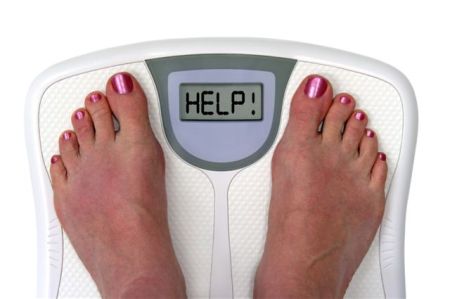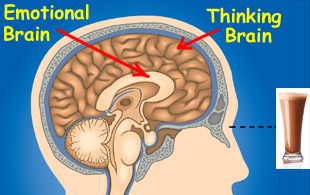 |
BlubberBusters Tips
from Lucy (Click here for past week's tips) |
||
Weight Plateaus - What To Do When You Think You Are StuckWeight Loss Stalled?Compliments From Others Stopped?What Do I Do Now?Don't hear, "You look great!" "You've lost more weight!" anymore? Has the excitement of seeing that you've dropped a few more pounds on the scale vanished because your weight has leveled off? What's wrong? You're eating and exercising the same as before but the scale doesn't budge! What's up with that? Could be you've hit a WEIGHT PLATEAU! Don't get discouraged. It's normal for weight loss to slow down as your body lightens up and your brain resists the changes in your eating. You're thinking, what's the use? Warning: Don't go back to your old overeating habits! It's just a stage of weight loss most everyone goes through. You can get pass it!
WHAT CAUSES A WEIGHT PLATEAU
As your body gets lighter it takes less energy to move around. As a result, you burn less calories and weight loss is slower. The exercise and food amounts you ate at the beginning of your weight loss program aren't enough now. You will only maintain your weight by eating and exercising the same amount. To lose more weight, you will need to further increase your activity or decrease the calories you eat.
WHAT TO DO TO GET PAST THE PLATEAU
If you want to lose more weight, you will need to refocus and re-commit to your weight loss efforts. You must RE-TRAIN YOUR BRAIN! Our brain has an emotional part and a thinking part. Our EMOTIONAL brain can be tricking us, telling us to eat something that tastes really good to soothe our sadness, boredom, loneliness, stress, or depression. That's why you get cravings. It can even become like an addiction. But, our THINKING brain is more rationale and knows pretty much what food our body needs for energy and repairs. It knows you don't need the food you are craving at the moment and that it could result in renewed weight gain. Good News! The thinking part of the brain is BIGGER than the emotional part of the brain so YOUR THINKING BRAIN CAN LEARN TO CONTROL YOUR EMOTIONAL BRAIN. It just takes practice by becoming aware of what is going on. Practice talking to your brain and reasoning with your emotional brain. Say out loud, "No emotional brain! No! I am not going to let you trick me!! I do not need that food because I am not hungry. GO AWAY!!" Get in touch with your emotions and learn how to substitute other activities instead of using food for relief.
Many of us have never learned to deal with life's problems without eating them away. We need to learn to cope with life without turning to pleasurable food. - Make a list of things you like to do and substitute a fun activity instead of eating for pleasure. Usually, when you do these other activities, the desire to eat will go away. - Find motivation for not staying addicted to food. Make a list of why you hate being overweight and the reasons you want to be thinner. - Develop your self-esteem. What do other people like about you? What are you good at? What can you improve, besides your weight? Girls can take a makeup course and guys maybe a weight lifting course.
PLATEAU BUSTING IDEAS
PROBLEM FOOD CONTROL 1. Identify your problem foods. We usually have a few foods that we crave, chocolate, chips, sweets, etc. 2. Make a list of fun activities you like to do (go for a walk with your dog, start a garden, ride your bike). Refer to that list when you get a craving. 3. Pick one food on your list that you will work on at a time. When you have the urge to eat that food, go do something on your fun activity list instead of eating. Usually the urgent desire to eat will go away and you will have avoided tons of empty calories that would do nothing but put on more weight. If you can avoid that problem food for two weeks, the cravings pretty much disappear. PROBLEM FOOD AMOUNT CONTROL 1. Pick a CATEGORY of food. Categories might be foods such as Desserts, Fast Food, Fried Food, Junk Food, Snacks, Starches, Sweets, Take Out, Toppings and so forth. 2. Select a FREQUENCY. Choose a meal time such as breakfast, lunch, dinner, or snack time where you will limit the amount of your chosen food. 3. Pick a METHOD you will use to limit the amount, like these: - Cut Serving In Half. When you take your usual amount of a food in the category you selected, cut that food in half and only put half on your plate. Put the other half back. Out of sight, out of mind! In a restaurant, immediately cut the amount you're served in half and put the other half in a take home box. You can also split the order of food and share with a friend. Keep doing this. Pretty soon you won't miss the extra food. TRAIN YOUR BRAIN! - Half-Size Plate, Bowl, and Glass. Eat with a smaller plate, bowl, and glass. Research shows that we eat less with smaller plates. (Hint: a tall, skinny glass will seem like a lot more than it is.) - No 2nd Helpings. Don't eat any second helpings of your chosen food group, And don't overdo the first helping!! See, you CAN re-train your brain! Don't go back to your old habits! You've lost weight so learn to keep it off with some of these tips. Keep going forward! You Can Do It!! YOU CAN RE-TRAIN YOUR BRAIN!!! Let us know what you think of this tip. Make this a healthy week! (Click here for past week's tips) |
|||
Please ask your
healthcare provider if these tips are right for you and please read our disclaimer.


 The thinking brain and the emotional brain can sometimes be in a tug of war!
The thinking brain and the emotional brain can sometimes be in a tug of war!